Birds of pink are the most beautiful and enigmatic of all the avian species found in the world today. They come in a variety of shapes and sizes and can be found in almost every corner of the globe.
These birds have captivated the hearts and minds of people for centuries, as their vibrant colors and graceful movements have been admired by many. They are also a symbol of hope, as their presence often signifies new beginnings and fresh starts.
From their unique plumage to their fascinating behaviors, birds of pink are truly a marvel to behold.
1. Roseate Spoonbill
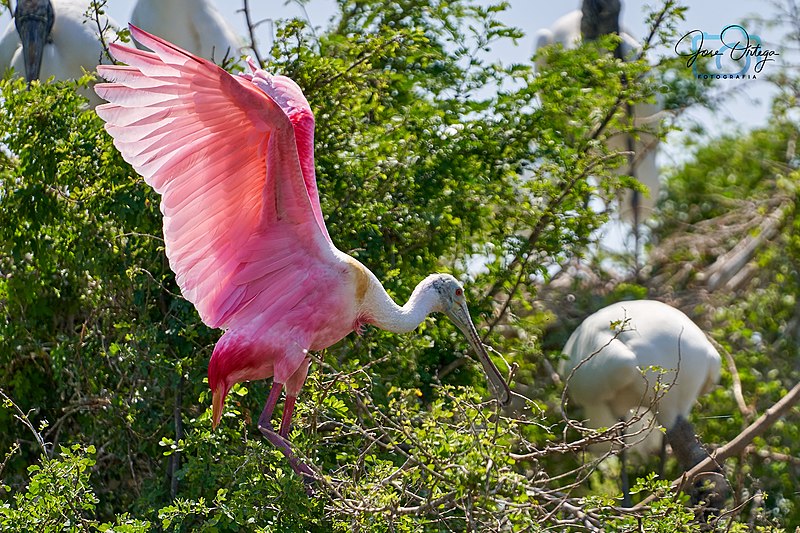
The Roseate Spoonbill is a beautiful and majestic bird found in both North and South America.
It belongs to the ibis family, Threskiornithidae, and its vibrant pink color comes from canthaxanthin pigment derived from their diet of crustaceans like shrimp.
Sadly plume hunting has almost driven this species close to extinction during the 18th and 19th centuries but fortunately, it’s making a comeback due to conservation efforts made by dedicated wildlife organisations.
Its large spoon-like bill helps them filter out food sources such as small fish or frogs from shallow water areas while they wade through mudflats with their long legs looking for something tasty.
With its unique appearance, graceful wingspan, and impressive flight capabilities, the Roseate Spoonbill is an incredibly photogenic animal that will captivate any viewer’s attention who happens to be lucky enough to witness it in all its glory.
Scientific classification:
| Kingdom | Animalia |
| Phylum | Chordata |
| Class | Aves |
| Order | Pelecaniformes |
| Family | Threskiornithidae |
| Genus | Platalea |
| Species | P. ajaja |
2. Spoonbills
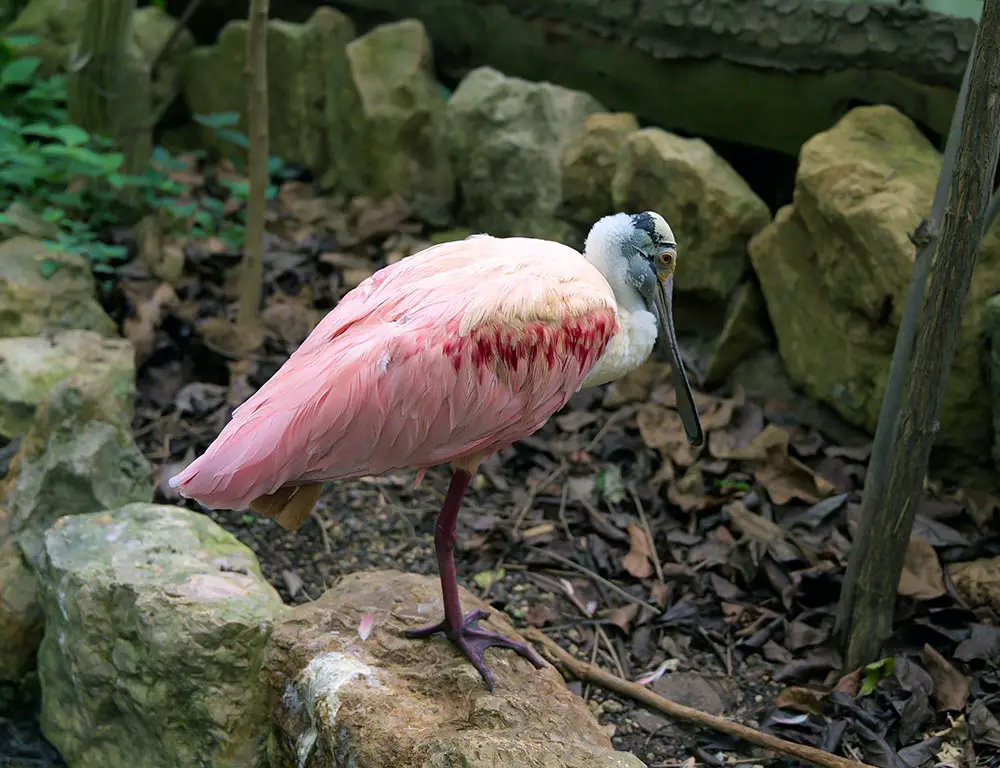
Spoonbills are large wading birds belonging to the genus Platalea. Characterized by their long legs and distinctive spoon-shaped beaks, these birds can be found all over the world except Antarctica.
The name of this genus derives from Ancient Greek meaning “broad”, referring to their bill’s shape.
There are six species of Spoonbill recognized – though they usually form a single group, sometimes it is divided into three genera.
These graceful creatures feed mainly on small aquatic organisms such as insects and fish which they catch with an open-mouth technique while sweeping through shallow waters in search for food.
They typically breed near water bodies during springtime when there’s plenty of food available around them.
Scientific classification:
| Kingdom | Animalia |
| Phylum | Chordata |
| Class | Aves |
| Order | Pelecaniformes |
| Family | Threskiornithidae |
| Subfamily | Plataleinae |
| Genus | Platalea Linnaeus, 1758 |
3. Greater Flamingos
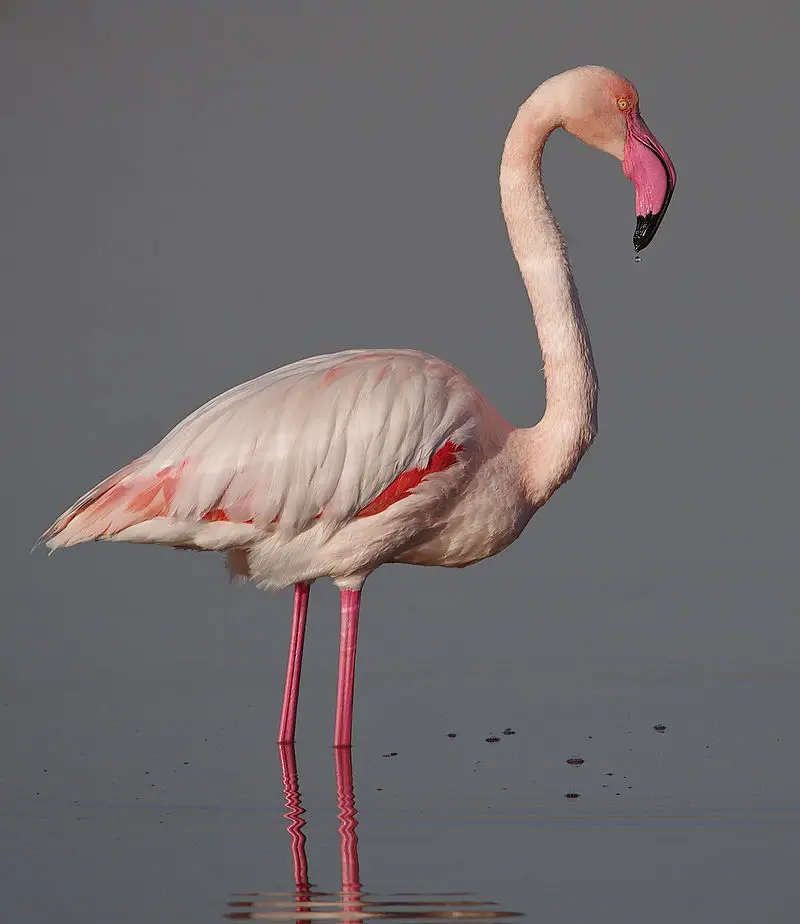
The Greater Flamingo (Phoenicopterus ruber) is the most widespread species of flamingo and can be found in parts of Europe, Africa, Asia, and South America.
It has an unmistakable bright pink plumage that stands out against its white feathers. Its long legs are also a distinguishing feature as they reach up to 46 inches long.
The bill is curved downwards with a black tip at the end, which makes it easy for them to filter food from water sources like lakes or lagoons.
This diet mainly consists of small shrimp-like crustaceans called brine shrimp along with other aquatic insects and plants.
They also have salt glands on their tongues that help remove excess salt from ocean waters when they drink seawater as part of their regular diet.
Scientific classification:
| Kingdom | Animalia |
| Phylum | Chordata |
| Class | Aves |
| Order | Phoenicopteriformes |
| Family | Phoenicopteridae |
| Genus | Phoenicopterus Linnaeus, 1758 |
4. Pink-Headed Fruit Dove
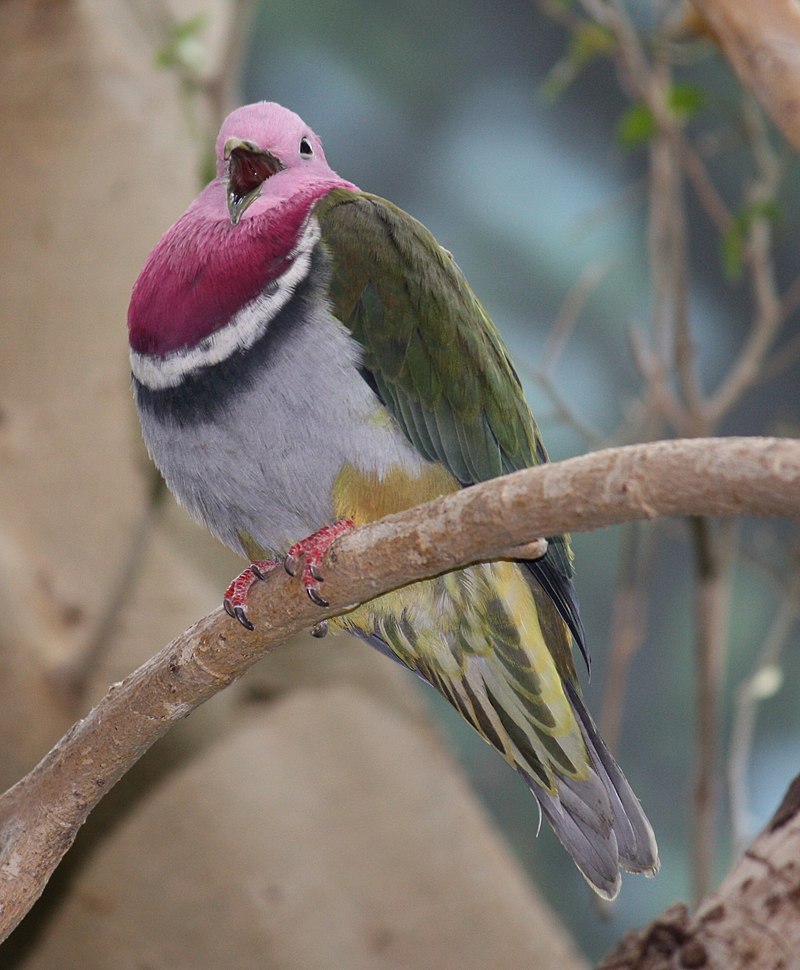
The Pink-headed Fruit Dove is an exquisite little bird, with a vibrant pink head and neck. It resides in the mountain forests of Indonesia at altitudes between 1000 to 2200 meters.
They build flimsy nests in trees and lay one or two white eggs per clutch. The rest of its plumage consists of bright green wings and tail, plus blue on its upper back feathers that shine under sunlight.
Its beak is blackish grey while orange eyes complete the stunning look. These birds feed mainly on small fruits found only in their native habitat such as figs but will also eat insects like termites for protein supplement.
In terms of behavior they are shy creatures rarely seen alone out from hiding spots inside thick vegetation; however, when breeding season comes they can be heard due to their distinctive chirping sounds which attract mates during courtship displays.
Scientific classification:
| Kingdom | Animalia |
| Phylum | Chordata |
| Class | Aves |
| Order | Columbiformes |
| Family | Columbidae |
| Genus | Ptilinopus |
| Species | P. porphyreus |
Also Featured In: Birds that Commonly Found in Bali, Java Birds You Should Know
5. Pink Robin
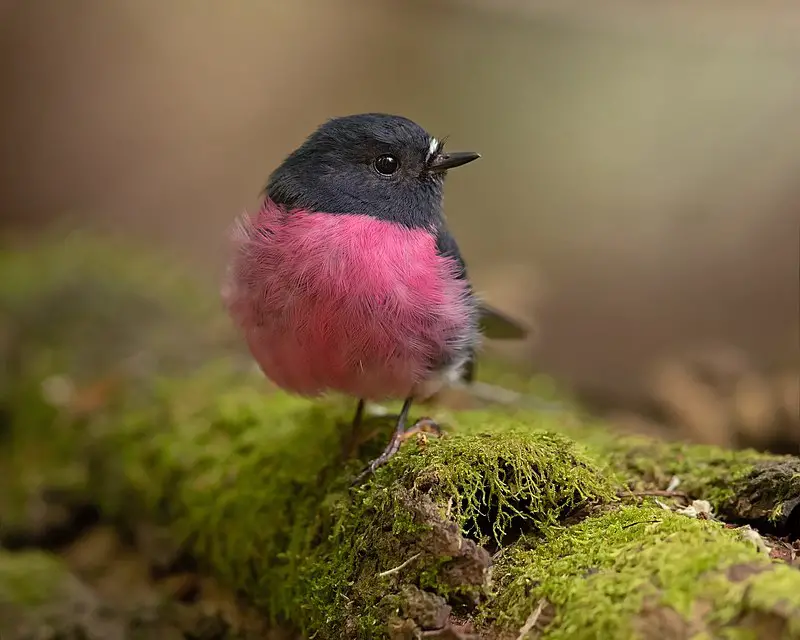
The Pink Robin is a small passerine bird native to southeastern Australia. Its vibrant plumage makes it instantly recognizable, with the males sporting vivid pink feathers on their chest and head while females are brownish-gray above and whitish below.
The species measures 13.5 cm in length and has a black bill, dark brown eyes, and legs.
This beautiful robin typically inhabits cool temperate forests of far southeastern Australia where they feed mainly on insects found among foliage or close to the ground surface due to its short wingspan which restricts flight performance for extended periods.
As such, much of its activity takes place near dense vegetation cover protecting from predators as well as access to food resources necessary for survival in this challenging environment.
Scientific classification:
| Kingdom | Animalia |
| Phylum | Chordata |
| Class | Aves |
| Order | Passeriformes |
| Family | Petroicidae |
| Genus | Petroica |
| Species | P. rodinogaster |
Also Featured In: Birds that Live around Victoria,
6. Galah
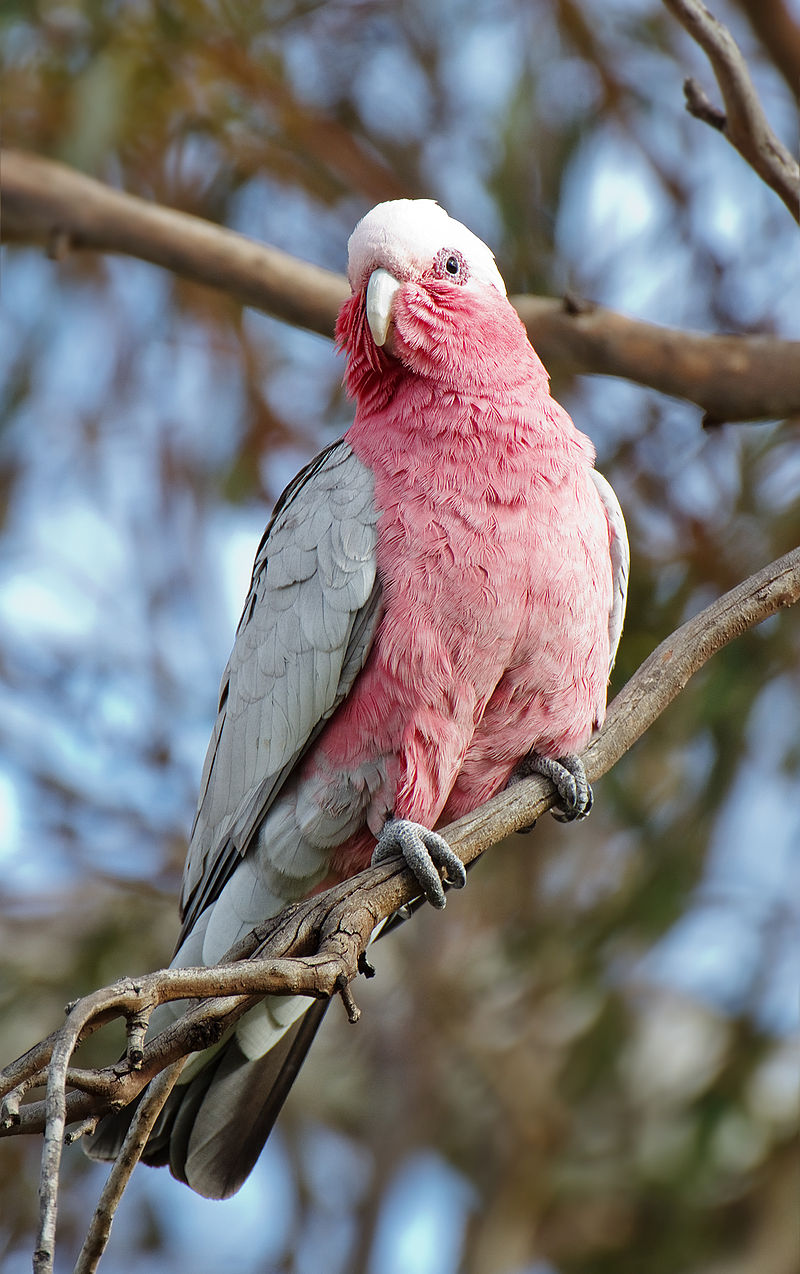
The Galah is a striking bird, easily identified by its distinctive pink and grey plumage. It belongs to the cockatoo family and is found throughout Australia.
With its loud call, it’s not hard to spot this vibrant bird in both rural and urban settings. They are also known as rose-breasted cockatoos due to the bright feathers on their chest.
These birds form strong relationships with each other, living together in pairs or small groups while they look for food in grasslands or open woodlands.
Their diet consists of seeds, fruits, buds & flowers making them valuable contributors to ecosystems across the country.
Scientific classification:
| Kingdom | Animalia |
| Phylum | Chordata |
| Class | Aves |
| Order | Psittaciformes |
| Family | Cacatuidae |
| Genus | Eolophus Bonaparte, 1854 |
| Species | E. roseicapilla |
7. Major Mitchell’s Cockatoo
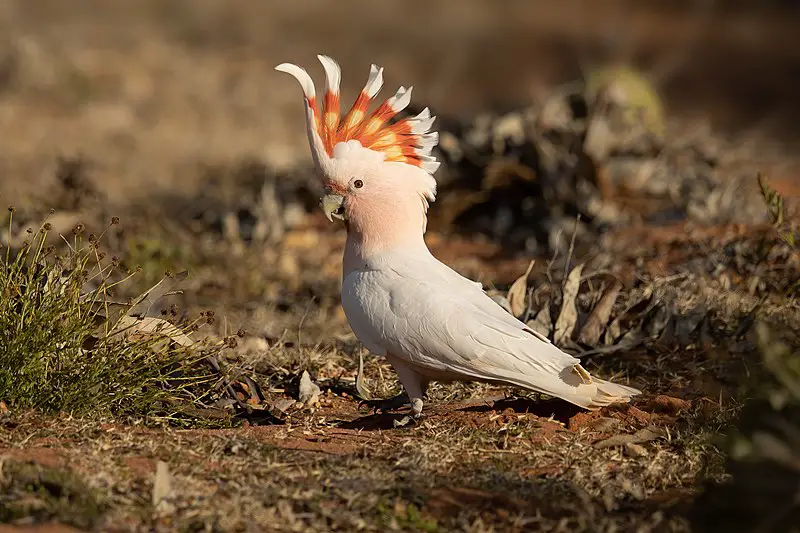
The Major Mitchell’s cockatoo is a medium-sized bird native to arid and semi-arid regions of Australia. It has been seen in other climates, such as South-East Queensland’s subtropical region.
The species was first described by Irish naturalist Nicholas Aylward Vigors in 1831 under the name Plyctolophus leadbeateri.
This pink cockatoo has distinctive grey downy feathers on its back and wings which contrast with its snowy white head, chest, and tail feathers.
Its red crest stands out against the otherwise monochrome body when it spreads open during displays of excitement or aggression.
Despite being quite rare, these birds are hardy survivors that can live up to 80 years if given proper care and nutrition.
Scientific classification:
| Kingdom | Animalia |
| Phylum | Chordata |
| Class | Aves |
| Order | Psittaciformes |
| Family | Cacatuidae |
| Genus | Lophochroa Bonaparte, 1857 |
| Species | L. leadbeateri |
8. Greater Flamingo
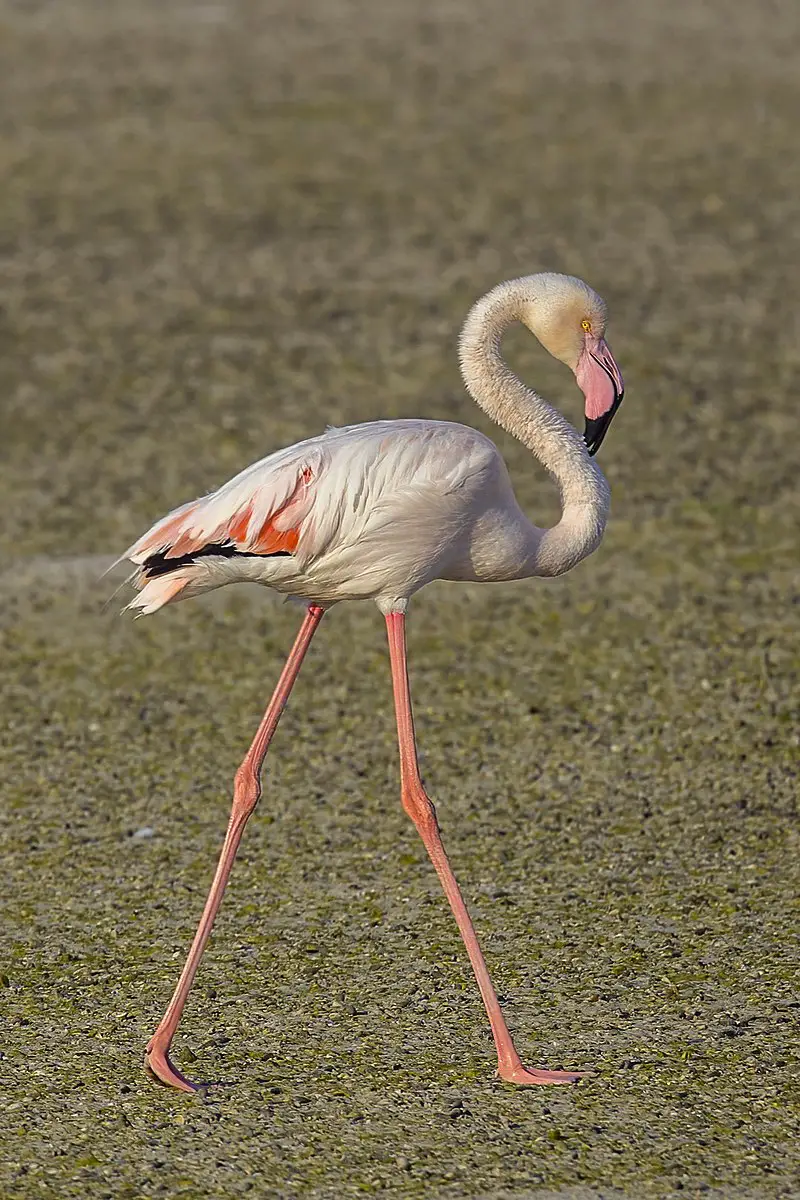
The Greater Flamingo is an impressive bird belonging to the Phoenicopteridae family. It’s one of the most widespread and largest species among flamingos with a range covering Africa, India, the Middle East, and southern parts of Europe.
The bird was described by Peter Simon Pallas in 1811 but it wasn’t until recently that it was distinguished from American Flamingo (Phoenicopterus ruber), due to differences in coloration between them.
This large-bodied wading bird stands tall at 1m on average and has bright pink plumage adorning its long neck and legs which gives way to black wing tips when flying.
Its diet mainly consists of algae, crustaceans as well as small aquatic animals like mollusks found while they feed along shallow lakes or lagoons where they live their social lives surrounded by others just like them.
Scientific classification:
| Kingdom | Animalia |
| Phylum | Chordata |
| Class | Aves |
| Order | Phoenicopteriformes |
| Family | Phoenicopteridae |
| Genus | Phoenicopterus |
| Species | P. roseus |
9. Bourke’s Parrot
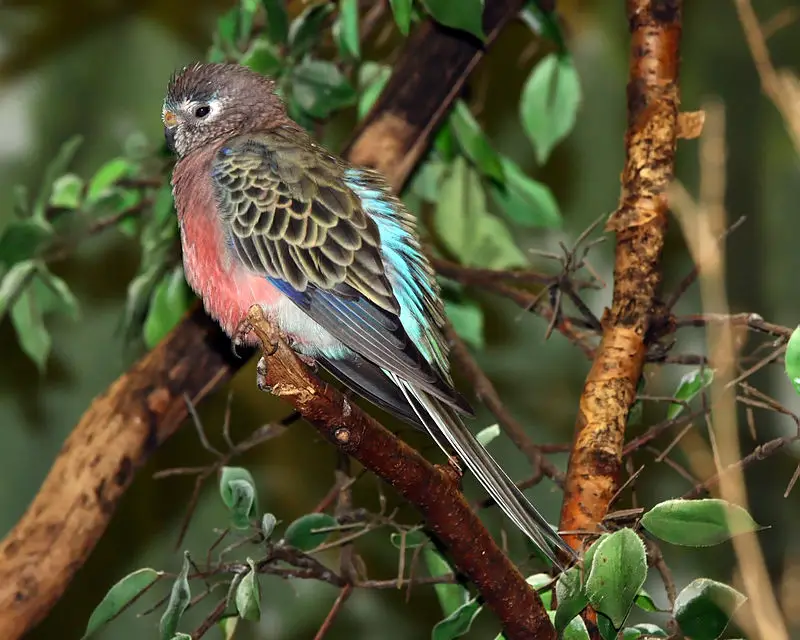
Bourke’s parrot is a small and colorful bird native to Australia. It has an olive-green body with blue feathers on the wings and tail, a pinkish chest, a white throat, and a yellow belly.
Its head is marked by two black stripes that run from its bill down its neck. This species of parrot measures 19 cm in length and weighs around 45 grams.
The Bourke’s Parakeet was named after General Sir Richard Bourke who served as Governor of New South Wales for six years beginning in 1831.
They are mainly found inhabiting dry areas such as shrublands or deserts but can also be seen in grassland habitats during the wet season when food is more abundant there.
These birds feed mostly on seeds, fruits, buds, and flowers which they pick up while flying through their environment looking for sustenance.
Scientific classification:
| Kingdom | Animalia |
| Phylum | Chordata |
| Class | Aves |
| Order | Psittaciformes |
| Family | Psittaculidae |
| Tribe | Pezoporini |
| Genus | Neopsephotus Mathews, 1912 |
| Species | N. bourkii |
Also Featured In: Aviary Birds You Should Know, Case Birds that Live in with Us
10. Rosefinches
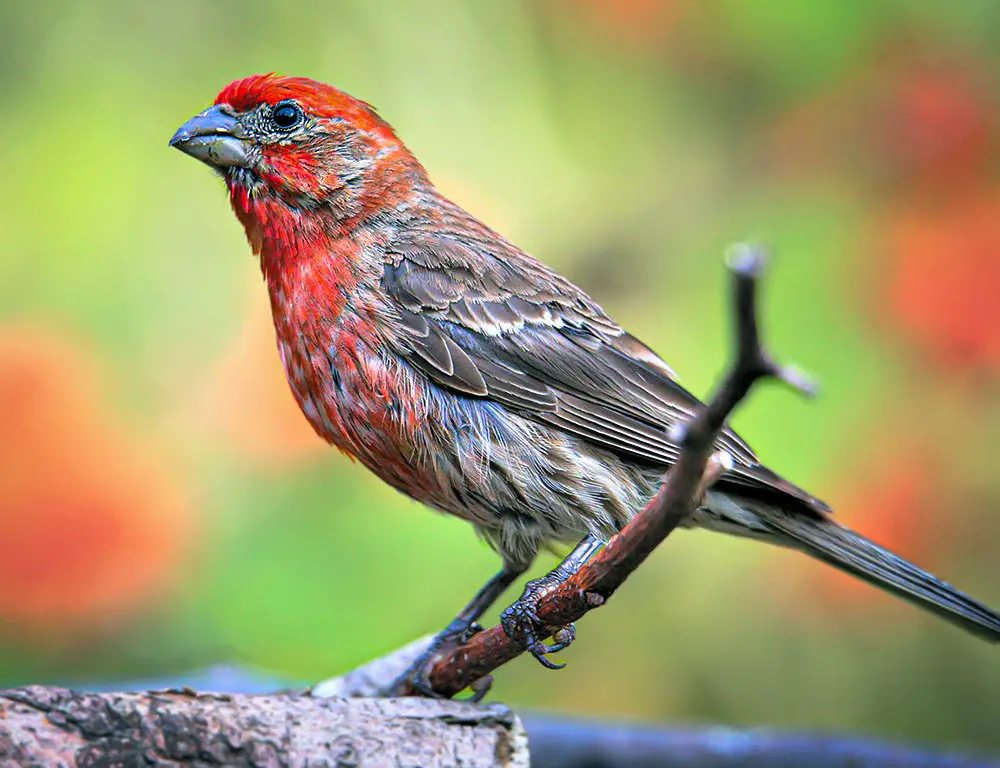
Rosefinches are a genus of passerine birds in the finch family Fringillidae known for their shades of red plumage. They have adapted to most habitats, including urban areas and can be found throughout Eurasia.
Rosefinches typically feed on small seeds, buds, flowers, and insects. Their diet is supplemented with fruits such as pomegranate or rose hips during cold winters when natural food sources become scarce.
These beautiful little birds also form large flocks which protect them from predators while they search for food together.
The Carpodacus rosefinch is an important species to many cultures because it has been kept as a pet by humans since ancient times due to its attractive colors and friendly nature compared to other wild bird species.
Overall these delightful creatures make wonderful companions that bring joy not only through sight but sound too.
Scientific classification:
| Kingdom | Animalia |
| Phylum | Chordata |
| Class | Aves |
| Order | Passeriformes |
| Family | Fringillidae |
| Subfamily | Carduelinae |
| Genus | Carpodacus Kaup, 1829 |
11. Brown-Capped Rosy-Finch
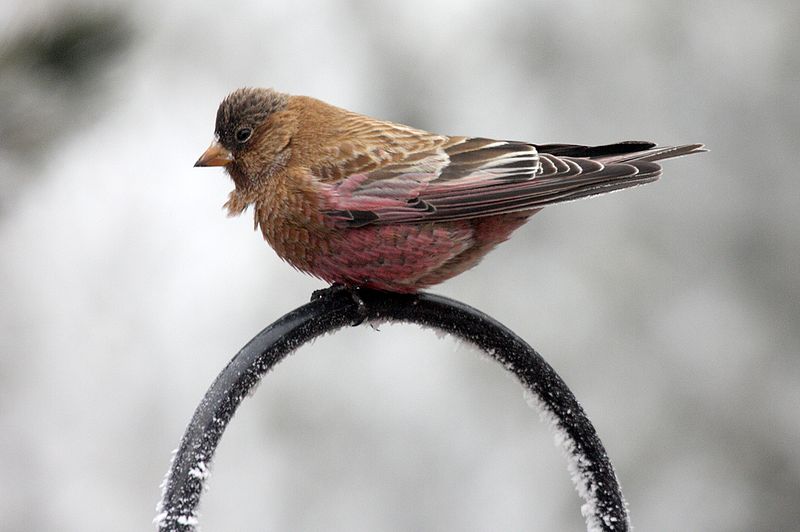
The Brown-capped Rosy-Finch is a medium-sized finch native to North America. Its distinctive features include its brown head, back, and breast with pink hues on the belly, rump, and wings as well as a black forehead.
It also has short black legs and a long forked tail. These birds prefer mountain peaks in central Rocky Mountain areas of the United States where they build cup nests in cavities or cliffsides.
They are known to feed on grasses, grains, and insects while migrating south during winter months when food resources become scarce at higher altitudes.
The Brown-capped Rosy-Finch is an interesting species that adds colour to rocky landscapes.
Scientific classification:
| Kingdom | Animalia |
| Phylum | Chordata |
| Class | Aves |
| Order | Passeriformes |
| Family | Fringillidae |
| Subfamily | Carduelinae |
| Genus | Leucosticte |
| Species | L. australis |
12. Pine Grosbeak
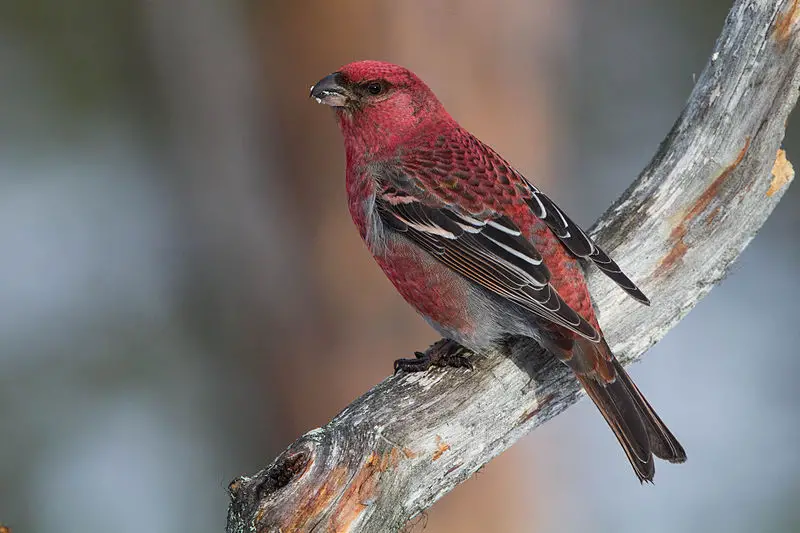
Pine grosbeak is a beautiful bird found across Alaska, the western US, Canada, and Fennoscandia to Siberia. It belongs to the family of true finch and it is the only species in its genus Pinicola.
This frugivorous bird has bright red feathers on its head and wings with yellowish-white underparts that make it very attractive.
During the winter season they feed mostly on small fruits like rowans, blueberries, etc., while during the summer months, their diet consists mainly of insects.
They are shy birds but can be seen perched at high branches or singing from the topmost trees if you look carefully enough.
Scientific classification:
| Kingdom | Animalia |
| Phylum | Chordata |
| Class | Aves |
| Order | Passeriformes |
| Family | Fringillidae |
| Subfamily | Carduelinae |
| Genus | Pinicola Vieillot, 1808 |
| Species | P. enucleator |
13. Chilean Flamingo
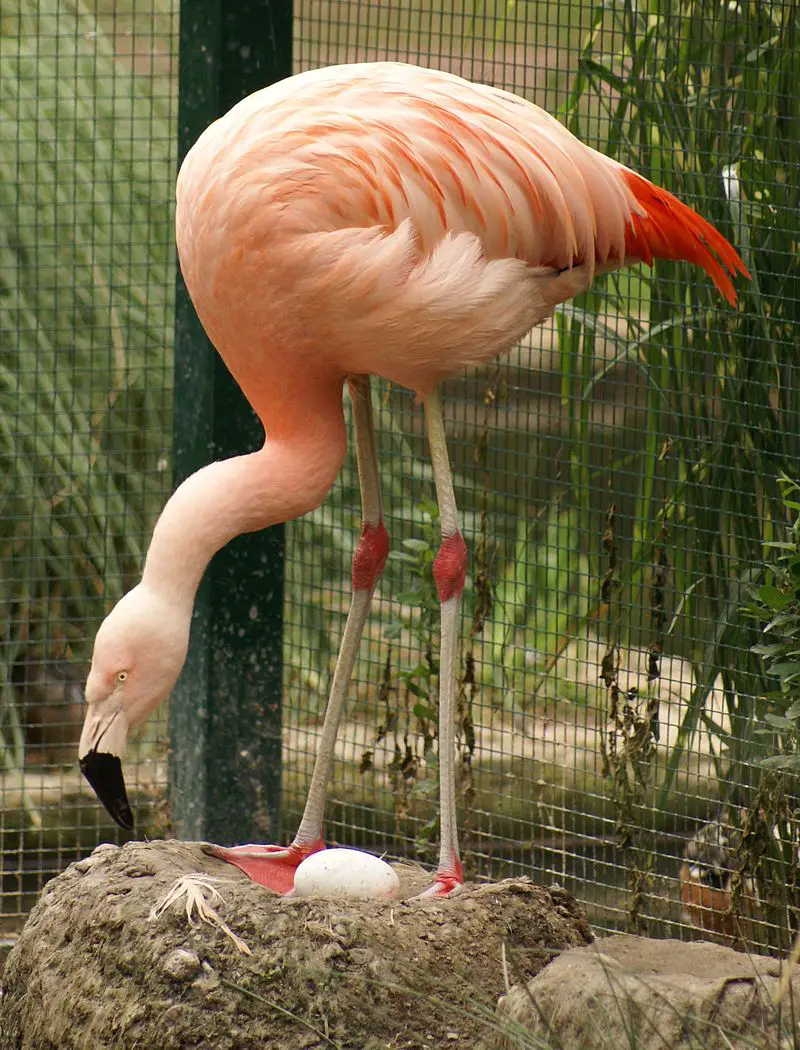
The Chilean Flamingo is a large bird native to South America, ranging from Ecuador and Peru to Chile and Argentina. It is an impressive species of flamingo which stands at 43-51 inches tall.
With its distinctive long neck, bright pink feathers, and black-tipped wings – it truly is a sight to behold.
Unfortunately, the population of this majestic creature has been decreasing over time due to human activities such as hunting for their meat or eggs.
The IUCN currently lists them as near threatened – meaning we need to act now if we want future generations to get the chance to experience these beautiful birds in person.
We must be more responsible with our actions so that these iconic animals can live peacefully without fear of harm from humans.
Scientific classification:
| Kingdom | Animalia |
| Phylum | Chordata |
| Class | Aves |
| Order | Phoenicopteriformes |
| Family | Phoenicopteridae |
| Genus | Phoenicopterus |
| Species | P. chilensis |
14. Scarlet Ibis
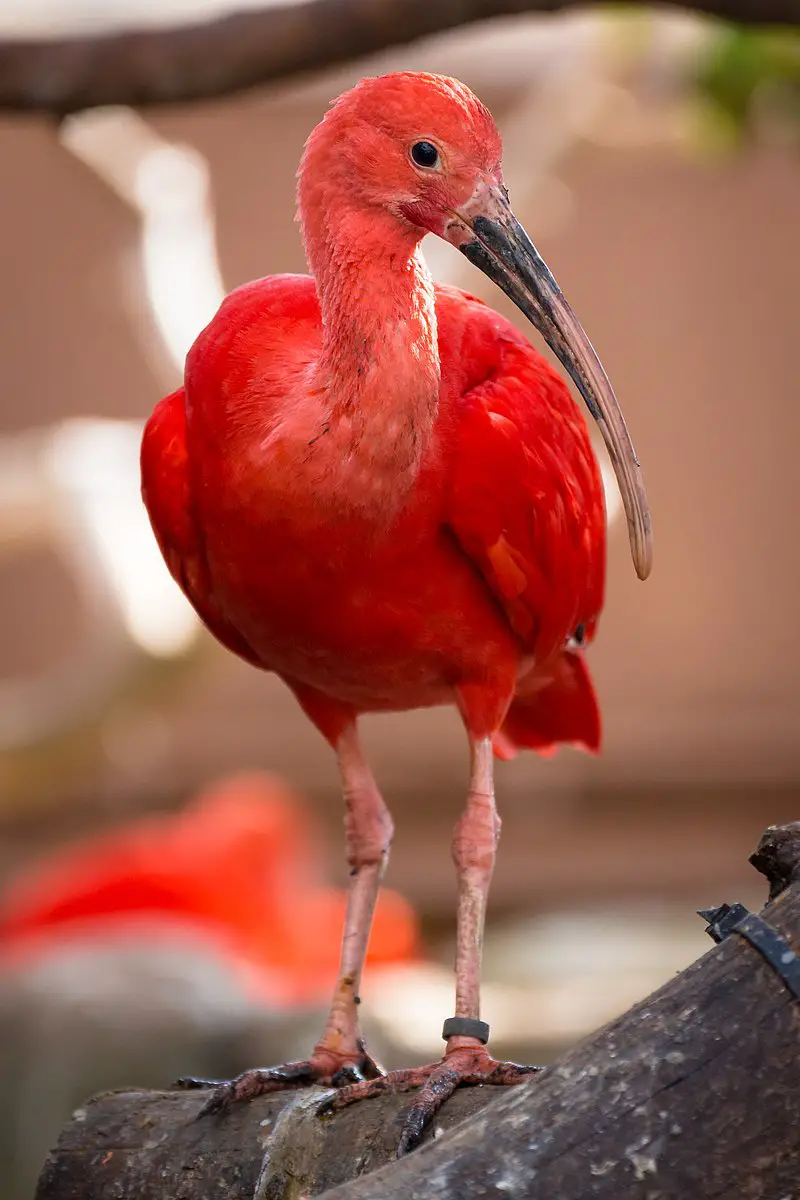
The Scarlet Ibis is a stunning bird, native to tropical South America and the Caribbean. With its distinctive scarlet coloration, it stands out from other ibises in the Threskiornithidae family.
It has become one of two national birds of Trinidad and Tobago with a Tupi-Guarani name: guará.
This species can grow up to 28 inches long with an impressive wingspan of 39–41 inches wide.
The striking red feathers are found mainly on their body while wings, head, and neck range from white or greyish colors.
They have black legs with pink webbed feet that help them thrive as they wade through shallow water searching for food such as shrimp, crabs, and small fish – all essential components to their diet.
Despite its beauty, this species faces threats due to increasing habitat destruction caused by deforestation practices in areas where it lives making conservation efforts crucial for protecting these majestic creatures before they disappear forever
scientific classification:
| Kingdom | Animalia |
| Phylum | Chordata |
| Class | Aves |
| Order | Pelecaniformes |
| Family | Threskiornithidae |
| Genus | Eudocimus |
| Species | E. ruber |
15. Two-Barred Crossbill
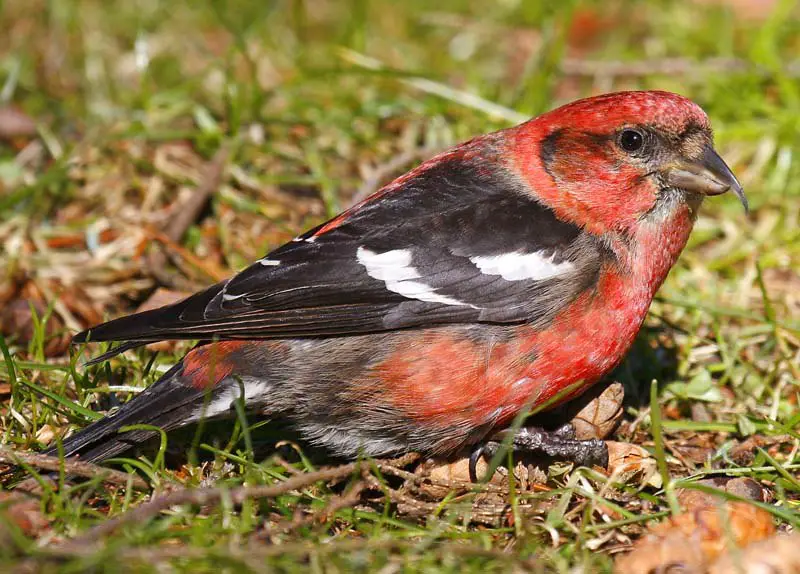
The Two-barred crossbill is a small passerine bird belonging to the finch family Fringillidae.
It gets its scientific name, Loxia leucoptera, from Ancient Greek – with ‘Loxia’ meaning ‘crosswise’ and ‘leucoptera’ translating to “white-winged” about its white wings.
The species has two subspecies: the white-winged crossbill (Loxia leucoptera leucoptera) that can be found in North America and the two-bar crossbill (Loxia leucocephala) which inhabits Europe, Asia as well as parts of northern Africa.
These birds feed mainly on conifer seeds but have also been seen consuming insects such as beetles or caterpillars during breeding season when food resources are scarce for their young ones.
They construct nests made out of twigs near trunks of spruce trees where they lay 2–6 eggs at one time.
Scientific classification:
| Kingdom | Animalia |
| Phylum | Chordata |
| Class | Aves |
| Order | Passeriformes |
| Family | Fringillidae |
| Subfamily | Carduelinae |
| Genus | Loxia |
| Species | L. leucoptera |
16. Salmon-Crested Cockatoo
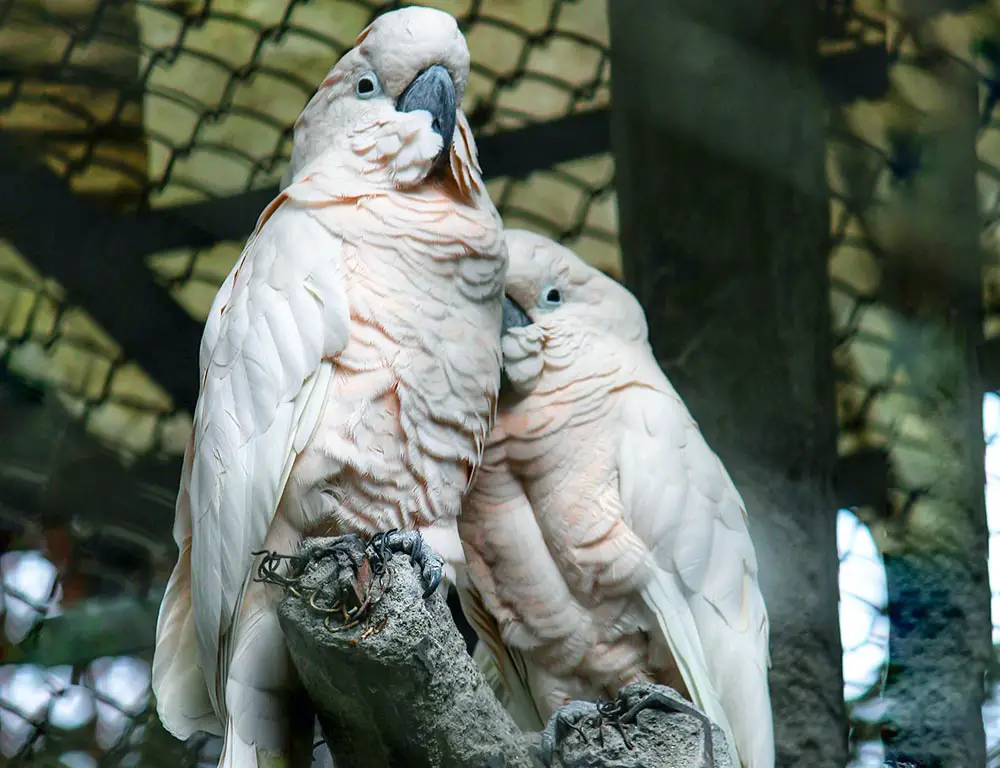
The Salmon-crested Cockatoo is an impressive bird, native to eastern Indonesia. It grows up to 46–52 centimeters tall and can weigh as much as 850 grams.
Its white-pink feathers form a distinct crest on its head that gives it the nickname Moluccan cockatoo. Females are slightly smaller than males, but both sexes have curved beaks with black tips, yellow eyes, and grey feet.
This species of parrot has sadly become endangered due to illegal trapping for trade in the pet industry and the destruction of habitat by deforestation.
Conservation efforts must be taken to protect this beautiful creature from further decline.
Scientific classification:
| Kingdom | Animalia |
| Phylum | Chordata |
| Class | Aves |
| Order | Psittaciformes |
| Family | Cacatuidae |
| Genus | Cacatua |
| Subgenus | Cacatua |
| Species | C. moluccensis |
17. Himalayan White-Browed Rosefinch
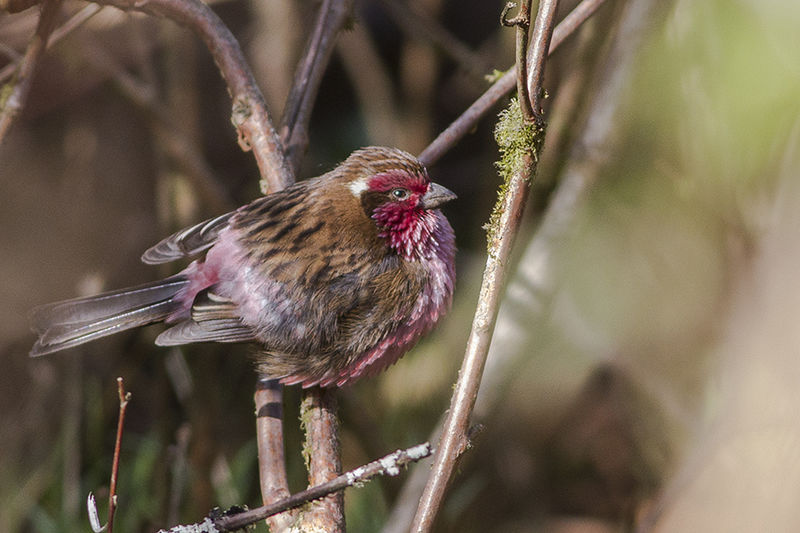
The Himalayan white-browed rosefinch is a beautiful finch species native to the Himalayas. It has an impressive range, ranging from Afghanistan in the west all the way eastwards into India, Tibet, Bhutan, and Nepal.
In its natural habitats, it prefers temperate forests or shrubland areas where plenty of food can be found.
Its plumage varies depending on region but usually consists of shades of browns with black patches and grey wings – hence its common name ‘white-browed’.
With a short bill, they feed mainly on grasses such as seeds and grains which are abundant in their environment.
They also take advantage of flowers that bloom during certain seasons for added nutrition throughout the year.
Scientific classification:
| Kingdom | Animalia |
| Phylum | Chordata |
| Class | Aves |
| Order | Passeriformes |
| Family | Fringillidae |
| Subfamily | Carduelinae |
| Genus | Carpodacus |
| Species | C. thura |
18. Southern Carmine Bee-Eater
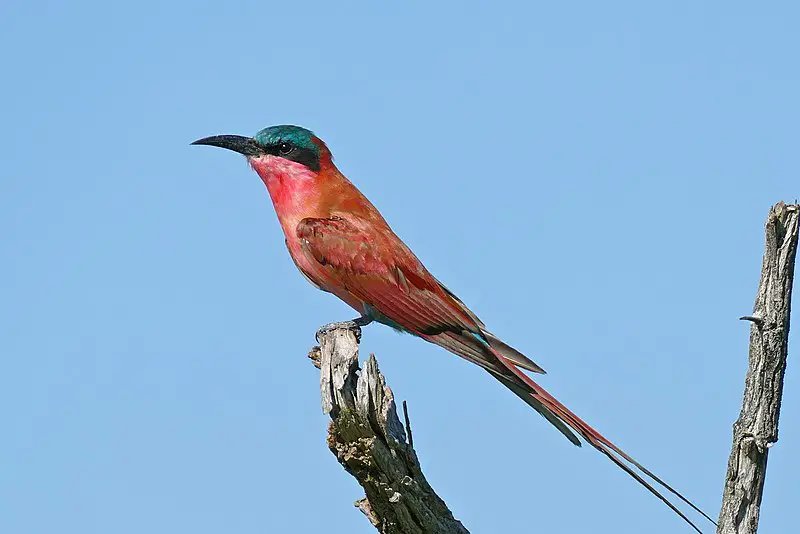
The Southern carmine bee-eater is a beautiful bird that can be found in subequatorial Africa. Its plumage is mainly carmine, but its crown and undertail are blue.
It ranges from KwaZulu-Natal and Namibia to Gabon, the eastern Democratic Republic of the Congo, and Kenya.
This species feeds on insects like bees or wasps which it catches midair with acrobatic swoops while they’re flying by.
When not hunting for food these birds often gather together in large flocks before going off again to feed individually or as pairs.
They also roost communally at night near their regular feeding grounds so they can quickly return when dawn breaks.
The Southern carmine bee-eater plays an important role in controlling insect populations making them essential members of African ecosystems.
Scientific classification:
| Kingdom | Animalia |
| Phylum | Chordata |
| Class | Aves |
| Order | Coraciiformes |
| Family | Meropidae |
| Genus | Merops |
| Species | M. nubicoides |
19. Cassin’s Finch
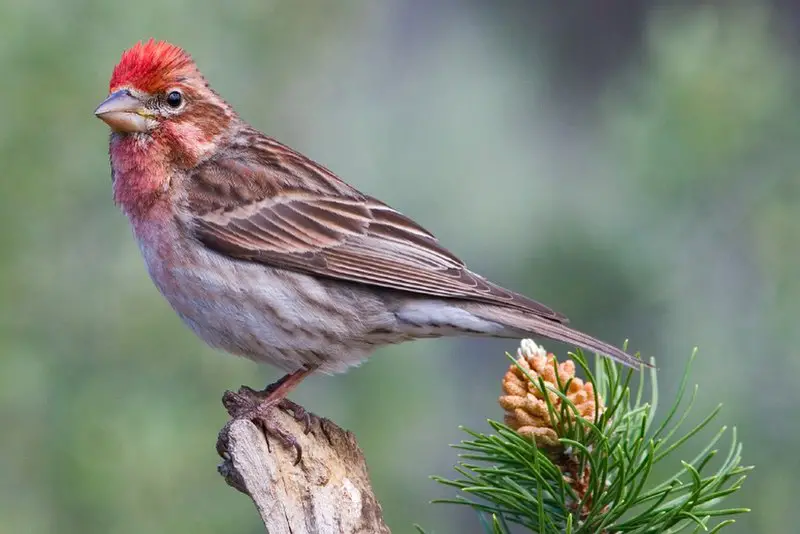
Cassin’s finch is a species of bird belonging to the Fringillidae family. It has brown wings and a tail, with a longer bill than that of the purple finch.
Adult males are raspberry red on their head, breast, back, and rump with streaked backs and undertail feathers.
The adult female Cassin’s Finch is duller in coloration than the male but still shows pinkish tones around its face and neck area as well as subtle streaks across its body.
This species can be found mainly in western North America from Alaska down to California where they inhabit coniferous forests along mountain slopes or near riversides at elevations between 500-3000 meters above sea level.
They feed mainly on grasshoppers, caterpillars, and other insects which they pick up while foraging through vegetation or by flying out onto open ground surfaces.
Scientific classification:
| Kingdom | Animalia |
| Phylum | Chordata |
| Class | Aves |
| Order | Passeriformes |
| Family | Fringillidae |
| Subfamily | Carduelinae |
| Genus | Haemorhous |
| Species | H. cassinii |
20. Pink-Headed Warbler
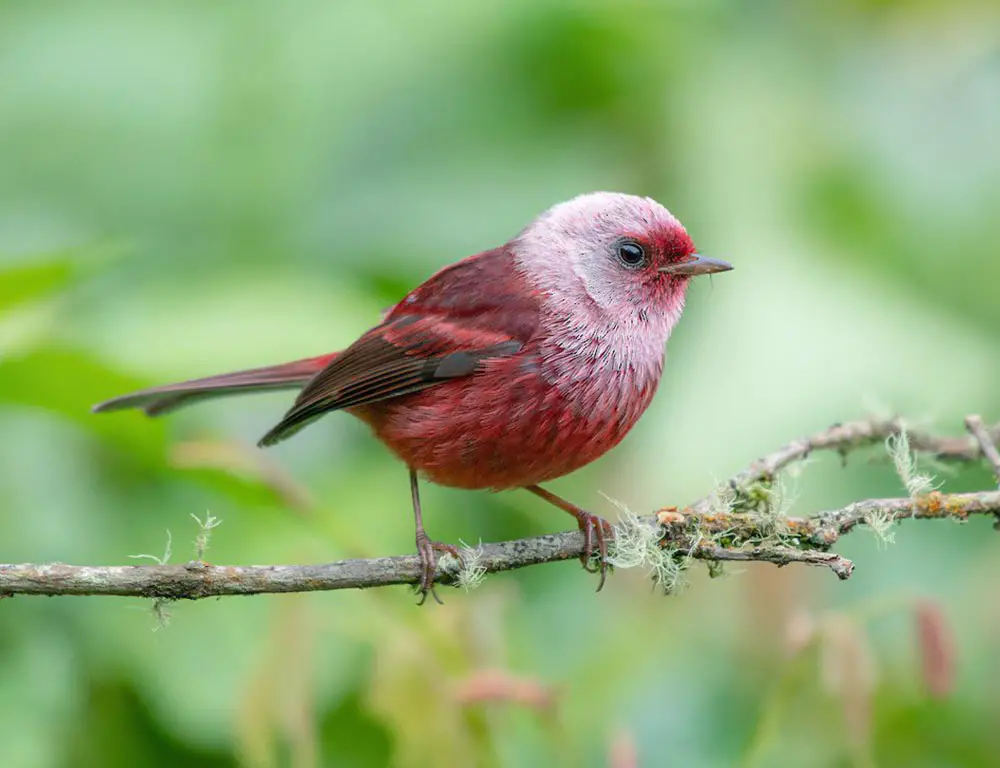
The Pink-headed Warbler is a small passerine bird found in Guatemala’s southwestern highlands and Mexico’s central and southeastern Chiapas state.
It has an eye-catching plumage, with its head and chest being silvery pink while the rest of its body is primarily red.
This beautiful warbler makes humid to semi-humid pine-oak, pine evergreen, or evergreen forests and edges at altitudes ranging from 7600 to 8700 feet their home.
They are fairly common inhabitants of these areas though they can be hard to spot due to their size.
Their diet consists mostly of insects making them important players in controlling insect populations that could cause major damage if left unchecked.
Scientific classification:
| Kingdom | Animalia |
| Phylum | Chordata |
| Class | Aves |
| Order | Passeriformes |
| Family | Parulidae |
| Genus | Cardellina |
| Species | C. versicolor |
21. Pink-Browed Rosefinch
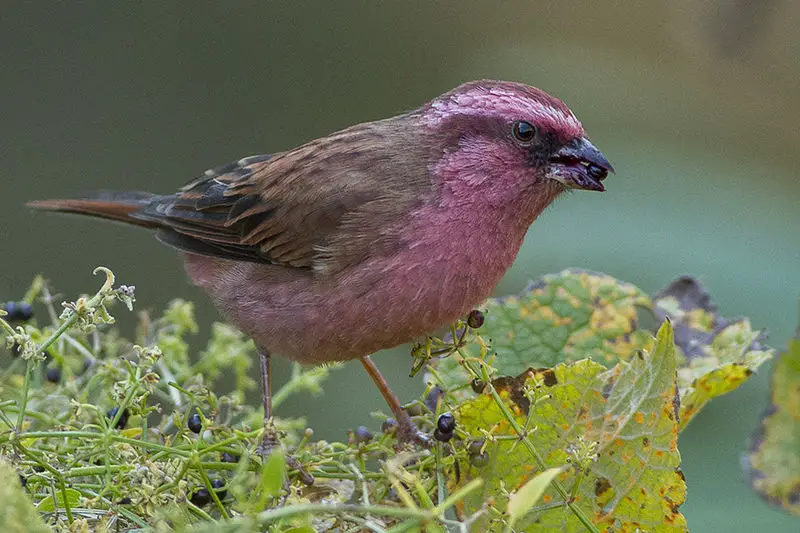
The Pink-browed Rosefinch is a beautiful bird found in the northern regions of the Indian subcontinent, mainly in the Himalayas. It has an unmistakable pinkish brow and upperparts, with a white belly and black wings.
During its migration, it can be seen across Bhutan, Tibet, India, Nepal, and Pakistan. This finch prefers boreal forests or dry subtropical climates but also visits open woodlands for feeding purposes.
Its diet consists mostly of seeds from grasses as well as other small plants such as clover or thistle flowers; insects are also reported to make up part of their diet during breeding season when extra protein sources are needed for chicks’ growth development.
With its vibrant plumage colors, this species makes a spectacular sight.
Scientific classification:
| Kingdom | Animalia |
| Phylum | Chordata |
| Class | Aves |
| Order | Passeriformes |
| Family | Fringillidae |
| Subfamily | Carduelinae |
| Genus | Carpodacus |
| Species | C. rodochroa |
22. Common Rosefinch
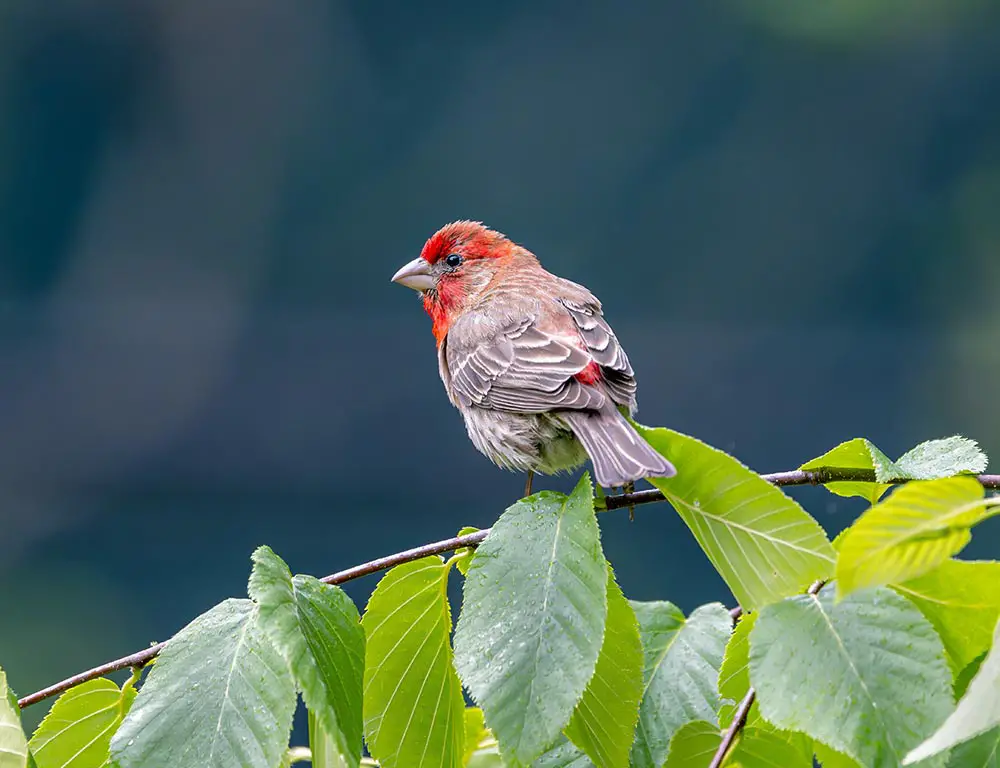
The Common Rosefinch (Carpodacus erythrinus) is a beautiful bird found throughout Europe and Asia. Its striking scarlet-red plumage helps it stand out amongst other finch species.
A 2012 study revealed that the Common Rosefinch was more closely related to Scarlet Finches than its own Carpodacus rosefinch clade, suggesting they evolved from a common ancestor.
Not only are these birds visually stunning but their sweet song has been compared to human whistling.
The nests of this species have also been noted for being intricately woven with plant material and spider webs, making them look like miniature baskets in trees or bushes.
These charming little birds make wonderful pets if given enough space – though some patience may be needed as their singing can last up to 3 minutes at times.
Scientific classification:
| Kingdom | Animalia |
| Phylum | Chordata |
| Class | Aves |
| Order | Passeriformes |
| Family | Fringillidae |
| Subfamily | Carduelinae |
| Genus | Carpodacus |
| Species | C. erythrinus |
23. Lilac-Breasted Roller
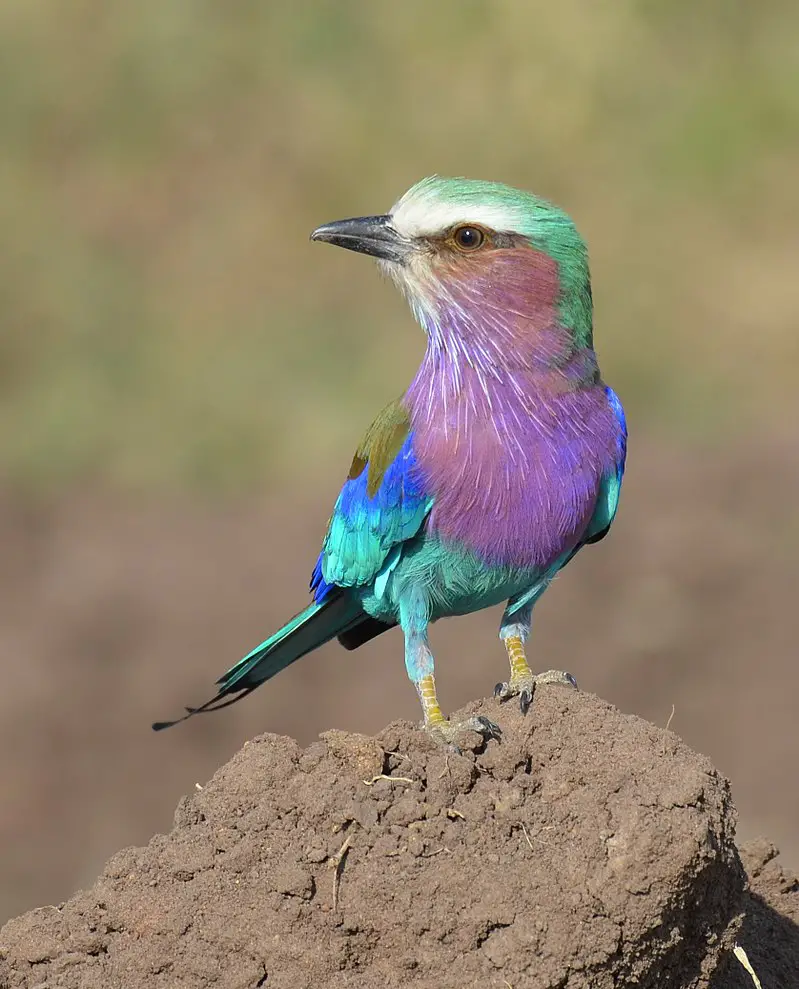
The Lilac-breasted Roller is a spectacular bird native to Southern and Eastern Africa, with occasional appearances in the southern Arabian Peninsula.
With its bright purple chest plumage and distinct black stripes on its wings and tail feathers, it stands out among birds of the same family.
It is usually found alone or in pairs perched atop trees or other high viewpoints, often used as lookout points for predators.
This species prefers open areas such as woodlands and savannas; it avoids treeless places like deserts due to their lack of protection from potential dangers.
Its call is loud and melodious – an unmistakable sound echoing through African skies.
Scientific classification:
| Kingdom | Animalia |
| Phylum | Chordata |
| Class | Aves |
| Order | Coraciiformes |
| Family | Coraciidae |
| Genus | Coracias |
| Species | C. caudatus |
24. Pink Pigeon
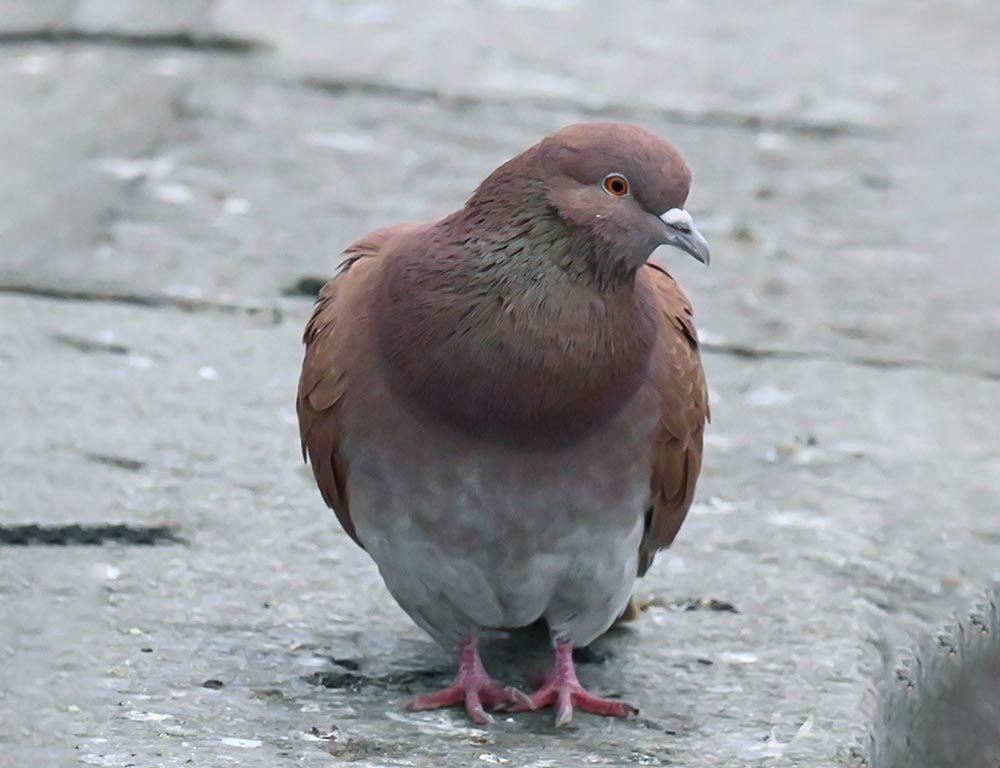
The Pink Pigeon is an incredibly rare bird found only on the island of Mauritius. Its population was severely impacted in both the 1970s and 1990s, with numbers dropping to just 10 individuals by 1991.
Fortunately, conservation efforts have been successful in increasing their numbers again. This species is peculiar for being the sole survivor among all Mascarene pigeons that once inhabited that region.
The Pink pigeon has a unique pinkish-grey coloration as well as black markings around its eyes and beak – features not seen anywhere else among other birds.
It lives mainly near forests or woodlands where it feeds on fruit, berries, and seeds from native plants while avoiding predators such as rats or cats whenever possible.
The future looks bright for this species thanks to dedicated conservation efforts over recent years but continued protection will still be necessary if extinction is to be avoided forevermore.
Scientific classification:
| Kingdom | Animalia |
| Phylum | Chordata |
| Class | Aves |
| Order | Columbiformes |
| Family | Columbidae |
| Genus | Nesoenas |
| Species | N. mayeri |
25. Pink-Throated Twinspot
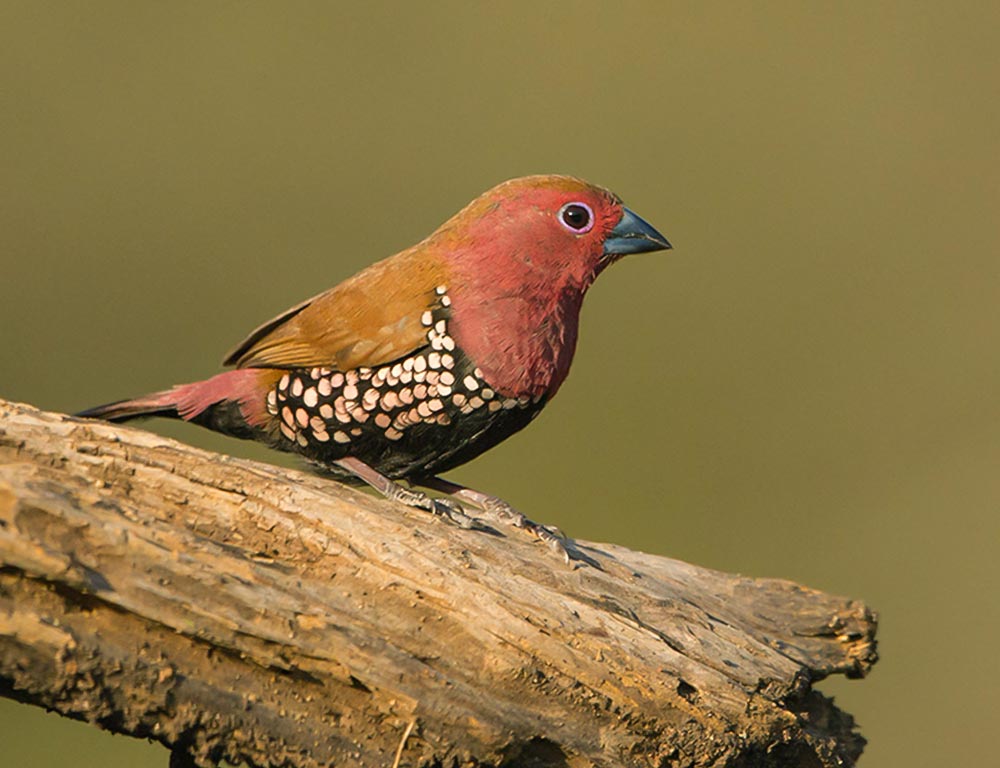
The Pink-throated Twinspot is a beautiful small bird found in Southeast Africa. It inhabits dry savanna and moist, subtropical/tropical shrubland habitats near the coast of Mozambique, South Africa, and Eswatini.
The species has an impressive range with an estimated global extent of occurrence at 160,000 km2 – making it one of the more widespread birds in its region.
As seed eaters, they can be found foraging on or around ground vegetation or trees depending on their environment.
They are easily identified by their striking pink throats which contrast against black wings and white spots along the back.
This makes them quite distinct from other local fauna so have become well known to locals as friendly backyard visitors.
Scientific classification:
| Kingdom | Animalia |
| Phylum | Chordata |
| Class | Aves |
| Order | Passeriformes |
| Family | Estrildidae |
| Genus | Hypargos |
| Species | H. margaritatus |
26. Northern Carmine Bee-Eater
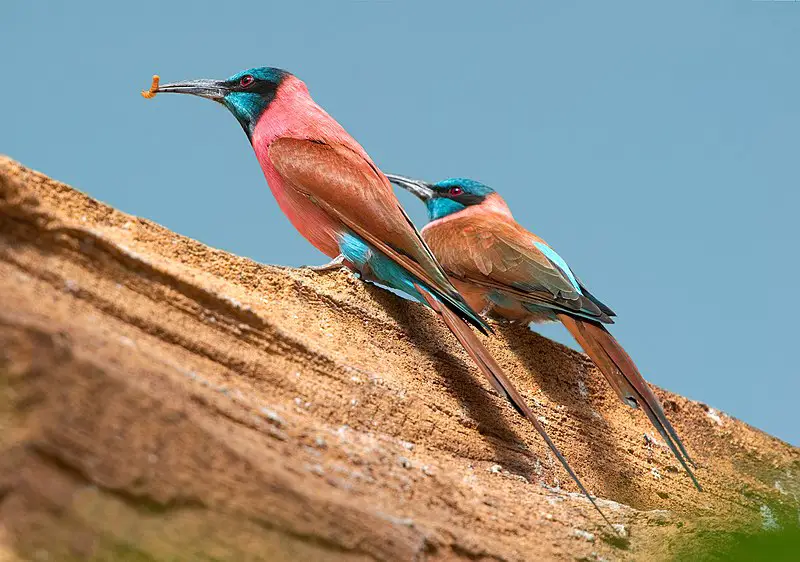
The Northern Carmine Bee-eater is a beautiful bird with striking colors. It has bright red and blue plumage, with the throat being predominantly carmine in color.
This species of bee-eater can be found throughout northern tropical Africa, from Senegal east to Somalia, Ethiopia, and Kenya.
It was previously assumed to be closely related to the Southern Carmine Bee-eater which has a scarlet-colored throat instead of blue as seen in this species.
The Northern Carmine Bee-Eater feeds on flying insects such as bees and other small creatures that it catches midair using its sharp claws and bills to grab them quickly before they escape.
Scientific classification:
| Kingdom | Animalia |
| Phylum | Chordata |
| Class | Aves |
| Order | Coraciiformes |
| Family | Meropidae |
| Genus | Merops |
| Species | M. nubicus |
Conclusion
In the colorful world of birds, pink feathered wonders bring a unique charm and diversity that captivates both ornithologists and nature enthusiasts alike.
This guide has taken us on a journey through 26 incredible species, showcasing the many shades and adaptations that make these birds so exceptional.
From the iconic flamingos to the elusive roseate spoonbill and the charming rosefinches, we’ve witnessed the beauty of nature’s artistry.
These pink birds serve as a reminder of the intricate and delicate balance of ecosystems and the importance of preserving their habitats.
With their vivid hues and fascinating behaviors, they continue to inspire awe and admiration.